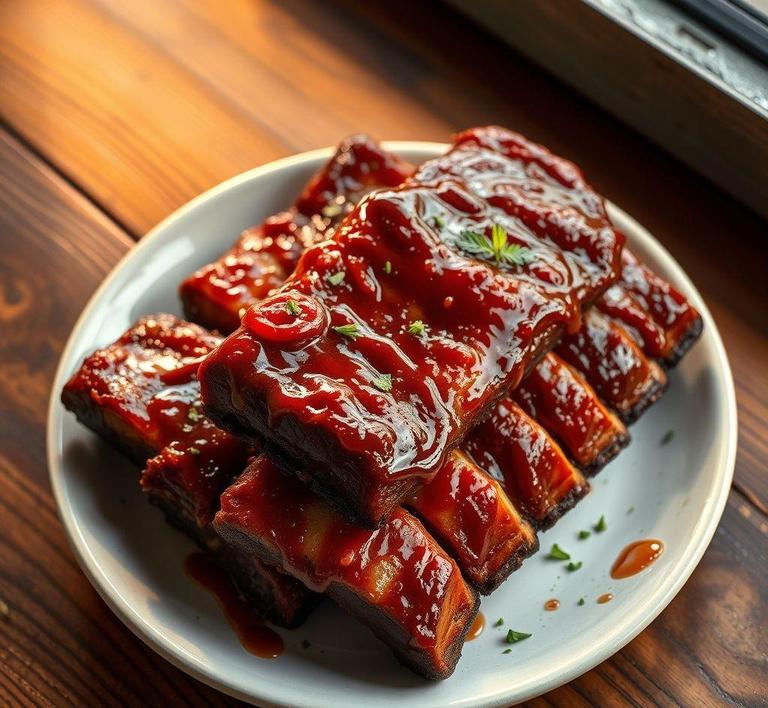Refreezing ribs might sound like a tricky idea, but it’s actually a pretty useful skill to have when you’ve cooked more than you can eat or if you’re trying to save some leftover ribs for later. The key to doing it safely and ensuring they still taste amazing is knowing the right steps. Whether you’re looking to preserve that smoky flavor or you’ve got a rib feast ahead and need to stash extras for a rainy day, this guide will walk you through how to properly refreeze ribs without sacrificing quality. From wrapping techniques to thawing tips, we’ve got you covered!
Can You Refreeze Ribs?

Refreezing ribs is a topic that often raises questions, particularly when it comes to food safety and the preservation of quality. The simple answer is yes, you can refreeze ribs, but there are several factors to consider that could impact the outcome. Like any other meat, ribs are perishable, and how they are handled throughout the freezing, thawing, and refreezing process plays a critical role in maintaining their safety and quality.
When you freeze ribs, you essentially put a pause on the clock in terms of bacterial growth and enzymatic processes that cause spoilage. However, once they are thawed, these processes can resume. If ribs are refrozen after thawing, the risk of bacterial contamination or spoilage increases. Refreezing also means the meat will experience further moisture loss, which can lead to a reduction in texture and flavor.
The key factors influencing whether or not refreezing ribs is a good idea include:
- How long the ribs have been thawed: The longer they sit at room temperature or in the fridge, the greater the chance for bacterial growth. Thawing in the fridge is safer, as it keeps the meat at a lower, consistent temperature.
- The method of thawing: If ribs are thawed in the microwave or under running water, they may not have stayed in the ideal temperature range long enough to prevent bacteria growth. In these cases, refreezing is not advisable.
- How long the ribs have been frozen initially: If the ribs were frozen for a long period, refreezing them might further degrade their quality and safety.
So, while it’s technically possible to refreeze ribs, it’s essential to consider these variables to determine whether it’s safe and worth doing.
How To Refreeze Ribs?
If you’ve decided to refreeze ribs, following the proper procedure is essential to minimize the impact on their quality and ensure they remain safe to eat. Here’s a detailed guide to help you do it right:
-
Ensure Proper Thawing:
The first step in refreezing ribs is to ensure they’ve been thawed correctly. If you’ve defrosted them in the fridge, this is the best-case scenario for refreezing. Ribs should never be left at room temperature for more than two hours because harmful bacteria can multiply rapidly in the "danger zone" (between 40°F and 140°F). If they were thawed using faster methods like the microwave or warm water, be aware that the ribs might already be partially cooked, which makes refreezing less safe.
-
Check for Signs of Spoilage:
Before refreezing, inspect the ribs for any signs of spoilage. This includes an off smell, slimy texture, or discoloration. If the ribs have been left out for too long or show these signs, it’s better to discard them than risk foodborne illness.
-
Wrap the Ribs Properly:
One of the most important aspects of refreezing any meat is to prevent freezer burn, which happens when air comes into contact with the food. Use heavy-duty plastic wrap, freezer paper, or vacuum-seal bags to tightly wrap your ribs. The vacuum-seal method is especially effective as it removes air, preserving both moisture and flavor. If you don’t have a vacuum sealer, wrap the ribs tightly in plastic wrap and then in aluminum foil or a freezer bag. Make sure there’s as little air as possible.
-
Label and Date:
It’s easy to forget when you froze something, so label your ribs with the date of refreezing. This will help you track how long they’ve been in the freezer and ensure you use them within a reasonable time frame. Ribs should ideally be used within 2-3 months of being refrozen, as their quality will decline the longer they sit in the freezer.
-
Use Proper Freezing Temperatures:
Freezers should be set at 0°F (-18°C) or lower to maintain food safety. If your freezer doesn’t maintain this temperature, bacteria can still grow, even at freezing temperatures, and refrozen ribs could become unsafe.
Quality Impact
Refreezing ribs has a significant impact on both the texture and flavor, and it’s important to understand how these changes may affect your enjoyment of the meat. Here’s a breakdown of the primary quality issues:
-
Moisture Loss:
One of the most notable effects of refreezing is moisture loss. Each time you freeze and thaw meat, ice crystals form inside the cells, which can rupture the cell walls. When the meat is thawed again, moisture is released, leaving the ribs drier. This moisture loss results in a tougher texture and less juicy meat. While this isn’t a deal-breaker, it can make the ribs less tender and flavorful than fresh or only-frozen ones.
-
Flavor Deterioration:
As ribs are frozen and thawed repeatedly, their flavor profile can degrade. Freezing alters the natural enzymes in the meat, and while they’re dormant during freezing, they can resume activity once thawed. This can lead to changes in the taste, making the ribs slightly less fresh or flavorful. Additionally, the longer meat stays frozen, the more likely it is to absorb odors from other foods in the freezer, which can alter its taste.
-
Texture Changes:
Repeated freezing can cause textural changes, particularly in meats like ribs. Over time, the muscle fibers may break down, leading to a mushier or more fibrous texture. This is especially noticeable in ribs that were previously slow-cooked or smoked. The collagen and connective tissues that are responsible for the tender texture of well-cooked ribs may break down unevenly after being refrozen, resulting in a less satisfying eating experience.
-
Loss of Quality in Sauces or Marinades:
If the ribs were cooked with sauces or marinades, refreezing may affect the quality of those as well. Sauces can separate or become watery after thawing and refreezing, which can dilute the flavor. Additionally, any spices or herbs used in marinades may lose their potency, further affecting the overall taste.
While it is technically possible to refreeze ribs, it’s not always the best option from a quality perspective. Refreezing can affect the texture, flavor, and juiciness of the meat, as each cycle of freezing and thawing can cause moisture loss and changes to the structure of the meat. If you decide to refreeze ribs, make sure they are thawed safely, are still in good condition, and are wrapped properly to protect them from freezer burn.
Ultimately, the decision to refreeze ribs comes down to balancing food safety with quality. If the ribs have been thawed for a short time and handled properly, and if you take the right precautions, refreezing can be a safe and practical solution to avoid wasting food. However, if quality is a high priority, it may be best to plan to eat the ribs within a short time frame after thawing to preserve their flavor and texture.
Is It Safe To Refreeze Ribs?
Refreezing ribs, like other types of meat, is a common point of confusion and concern for many home cooks. The simple answer is: it depends. In theory, it’s safe to refreeze ribs as long as they have been thawed and stored properly. However, there are some important considerations to keep in mind. The key is understanding how food safety works, particularly with regard to temperature and the number of times the meat has been frozen and thawed.
When you freeze and thaw ribs, the cells in the meat release moisture, which can compromise the texture, flavor, and overall quality of the meat. This process, known as freezer burn, can make the meat less appetizing even though it’s technically still safe to eat. Additionally, there’s a danger of bacterial growth. Each time food is thawed, it enters a temperature range (typically between 40°F and 140°F) where bacteria can multiply rapidly. If ribs are refrozen after spending too long in this range, it could be unsafe to consume them later.
If your ribs were thawed in the refrigerator and haven’t been sitting out at room temperature for more than two hours, they are generally safe to refreeze. However, if the ribs were thawed at room temperature (for example, if you defrosted them on the countertop), it’s safer to avoid refreezing, as this could lead to the growth of harmful bacteria. The USDA recommends that perishable foods should not be refrozen if they’ve been above 40°F for more than two hours.
Signs That Ribs Should Not Be Refrozen
Refreezing ribs can be a great way to preserve leftovers or to store meat for later use, but there are some clear signs that indicate ribs should not be refrozen. Here are the most important red flags to look out for:
- Signs of Spoilage: If the ribs have an off smell, a slimy texture, or are discolored (especially turning green or gray), this is a sure sign that they should not be refrozen. Spoiled ribs should be discarded immediately to avoid foodborne illness.
- Extended Time at Room Temperature: If the ribs have been left out at room temperature for longer than two hours, it’s important not to refreeze them. Bacteria grow exponentially between 40°F and 140°F, and refreezing won’t kill the bacteria that may have already formed. You can check the temperature of the meat using a meat thermometer to ensure it hasn’t spent too much time in the danger zone.
- Freezer Burn: While freezer burn doesn’t necessarily make the ribs unsafe to eat, it can affect the texture and flavor. If the meat has large patches of discolored, dried-out surfaces due to exposure to air, it’s a sign that the ribs have been stored improperly and may have lost a significant amount of quality. While these ribs are still safe to eat, the quality will suffer.
- Thawing and Refreezing Multiple Times: If the ribs have already been thawed and refrozen multiple times, they may have lost a great deal of moisture and flavor. Each time the meat goes through a thaw-freeze cycle, the texture and taste deteriorate further, and refreezing again can lead to mushy and dry meat.
Common Refreezing Mistakes
- Not Properly Storing Ribs Before Refreezing: If you’ve thawed ribs in the refrigerator and they haven’t been exposed to unsafe temperatures, storing them improperly before refreezing can cause issues. For example, putting ribs back into the freezer without securely wrapping them in plastic wrap, foil, or vacuum-sealed bags will allow air to get to the meat, leading to freezer burn.
- Refreezing Without Cooling: If you attempt to refreeze ribs while they’re still warm or at room temperature, you’re giving bacteria the perfect opportunity to multiply. Always cool the ribs down completely before refreezing. This means letting them rest in the fridge for several hours before they are put back into the freezer.
- Refreezing After Extended Thawing: Thawing ribs for a long time can cause the outer layers of the meat to get warm enough for bacteria to grow. This is particularly true when using faster defrosting methods like microwave thawing or defrosting at room temperature. If ribs have been in these conditions for an extended period, they shouldn’t be refrozen.
- Not Labeling Frozen Meat: Labeling your ribs with the date of freezing is an important but often overlooked step. Without this, you could easily lose track of how long the meat has been frozen. Ideally, you want to consume the ribs within 4-6 months of freezing for the best quality. Beyond that, the risk of freezer burn and quality degradation increases.
Tips And Tricks
- Use Vacuum Sealing: One of the best ways to preserve the freshness of your ribs while freezing them is by using a vacuum sealer. Vacuum-sealed bags minimize the air exposure, which reduces the likelihood of freezer burn. They also make it easier to store ribs without taking up as much space in your freezer.
- Thawing Safely: If you plan to thaw your ribs before cooking, always do so in the refrigerator. Never thaw meat at room temperature, as this can encourage bacterial growth. If you need to thaw them more quickly, use the microwave or a cold-water bath, but avoid leaving them out for long periods.
- Freeze Smaller Portions: When freezing ribs, consider cutting them into smaller portions or removing the bones (if possible). Smaller portions freeze and thaw more efficiently and are easier to handle when you’re ready to cook them. This also reduces waste since you can defrost only what you need.
- Refreeze Within 24 Hours: If you’ve thawed the ribs in the refrigerator and you want to refreeze them, try to do it within 24 hours. The sooner you refreeze the meat, the less time bacteria have had a chance to grow. If it’s been longer than that, it’s safer to just cook the ribs.
- Cook Before Refreezing: If you’re unsure about refreezing raw ribs, consider cooking them before you freeze them. Once cooked, ribs can be safely frozen and will often retain better quality when reheated. Cooking the ribs prior to refreezing can also kill off any bacteria that might have developed during thawing.
Conclusion
Refreezing ribs can be a safe and effective way to preserve leftover meat, but it requires careful handling to maintain food safety and quality. The key to successfully refreezing ribs lies in proper storage, thawing, and understanding when it’s not safe to proceed. Always ensure that the ribs haven’t been left at room temperature for too long, are properly sealed to prevent freezer burn, and are not refrozen multiple times. While the risks of foodborne illness are generally low if these practices are followed, the biggest concern with refreezing ribs is usually the degradation of texture and flavor.
If done correctly, however, refreezing ribs can be an excellent option for making sure you don’t waste good food, while giving you flexibility in meal planning. By following the tips and tricks outlined here, you can minimize mistakes and enjoy your ribs, whether fresh or frozen, at their best.


